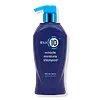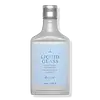What's inside
What's inside
 Key Ingredients
Key Ingredients

 Benefits
Benefits

 Concerns
Concerns

 Ingredients Side-by-side
Ingredients Side-by-side

Water
Skin ConditioningSodium Cocoyl Isethionate
CleansingSodium C14-16 Olefin Sulfonate
CleansingAcrylates/Aminoacrylates/C10-30 Alkyl PEG-20 Itaconate Copolymer
Emulsion StabilisingCocamidopropyl Betaine
CleansingSodium Lauroamphoacetate
CleansingAcetic Acid
BufferingAloe Barbadensis Leaf Juice
Skin ConditioningAmodimethicone
Aspalathus Linearis Leaf Extract
Skin ConditioningButylene Glycol
HumectantC11-15 Pareth-7
EmulsifyingCitric Acid
BufferingCocamidopropyl Dimethylamine
EmulsifyingDextrin
AbsorbentDisodium EDTA
Euterpe Oleracea Fruit Extract
Glycereth-26
HumectantGlycerin
HumectantGlycol Distearate
EmollientGlycol Stearate
EmollientHelianthus Annuus Flower Extract
Skin ConditioningHydrolyzed Hibiscus Esculentus Extract
Skin ConditioningLaureth-9
EmulsifyingMagnesium Chloride
Magnesium Nitrate
Morinda Citrifolia Fruit Extract
Skin ConditioningMoringa Oleifera Seed Extract
Skin ConditioningParfum
MaskingPEG-10 Sunflower Glycerides
EmollientPEG-150 Pentaerythrityl Tetrastearate
EmulsifyingPEG-55 Propylene Glycol Oleate
PEG-6 Caprylic/Capric Glycerides
EmulsifyingPoly(C20-28 Olefin)
Skin ConditioningPolyquaternium-10
Propylene Glycol
HumectantPunica Granatum Fruit Extract
AntioxidantSodium Ascorbyl Phosphate
AntioxidantSodium Chloride
MaskingSodium Glycolate
BufferingSodium Hydroxide
BufferingSodium Lauroyl Sarcosinate
CleansingSodium Sulfate
Symphytum Officinale Leaf Extract
Skin ConditioningTetrasodium EDTA
Trideceth-12
EmulsifyingZingiber Officinale Root Extract
MaskingChlorphenesin
AntimicrobialEthylparaben
PreservativeMethylchloroisothiazolinone
PreservativeMethylisothiazolinone
PreservativeMethylparaben
PreservativePhenoxyethanol
PreservativePotassium Benzoate
PreservativePotassium Sorbate
PreservativeSodium Benzoate
MaskingCoumarin
PerfumingHexyl Cinnamal
PerfumingLimonene
PerfumingWater, Sodium Cocoyl Isethionate, Sodium C14-16 Olefin Sulfonate, Acrylates/Aminoacrylates/C10-30 Alkyl PEG-20 Itaconate Copolymer, Cocamidopropyl Betaine, Sodium Lauroamphoacetate, Acetic Acid, Aloe Barbadensis Leaf Juice, Amodimethicone, Aspalathus Linearis Leaf Extract, Butylene Glycol, C11-15 Pareth-7, Citric Acid, Cocamidopropyl Dimethylamine, Dextrin, Disodium EDTA, Euterpe Oleracea Fruit Extract, Glycereth-26, Glycerin, Glycol Distearate, Glycol Stearate, Helianthus Annuus Flower Extract, Hydrolyzed Hibiscus Esculentus Extract, Laureth-9, Magnesium Chloride, Magnesium Nitrate, Morinda Citrifolia Fruit Extract, Moringa Oleifera Seed Extract, Parfum, PEG-10 Sunflower Glycerides, PEG-150 Pentaerythrityl Tetrastearate, PEG-55 Propylene Glycol Oleate, PEG-6 Caprylic/Capric Glycerides, Poly(C20-28 Olefin), Polyquaternium-10, Propylene Glycol, Punica Granatum Fruit Extract, Sodium Ascorbyl Phosphate, Sodium Chloride, Sodium Glycolate, Sodium Hydroxide, Sodium Lauroyl Sarcosinate, Sodium Sulfate, Symphytum Officinale Leaf Extract, Tetrasodium EDTA, Trideceth-12, Zingiber Officinale Root Extract, Chlorphenesin, Ethylparaben, Methylchloroisothiazolinone, Methylisothiazolinone, Methylparaben, Phenoxyethanol, Potassium Benzoate, Potassium Sorbate, Sodium Benzoate, Coumarin, Hexyl Cinnamal, Limonene
Water
Skin ConditioningSodium Lauroyl Sarcosinate
CleansingSodium Cocoyl Isethionate
CleansingSodium Lauroyl Methyl Isethionate
CleansingCocamidopropyl Hydroxysultaine
CleansingQuaternium-91
Acrylates Crosspolymer-4
Emulsion StabilisingGlycerin
HumectantAstrocaryum Murumuru Seed Butter
EmollientHydrolyzed Vegetable Protein
Skin ConditioningBabassuamidopropyl Betaine
CleansingZea Mays Oil
EmulsifyingHydrolyzed Hyaluronic Acid
HumectantSodium Hyaluronate
HumectantBHT
AntioxidantBrassica Campestris/Aleurites Fordi Oil Copolymer
Skin ConditioningC12-13 Pareth-23
CleansingCaprylyl Glycol
EmollientCinnamidopropyltrimonium Chloride
Citric Acid
BufferingCitrus Aurantium Amara Peel Oil
Skin ConditioningC12-13 Pareth-3
EmulsifyingCocamide Mipa
EmulsifyingDimethicone
EmollientDimethiconol
EmollientDipropylene Glycol
HumectantDisodium EDTA
Disteareth-75 Ipdi
Divinyldimethicone/Dimethicone Copolymer
Parfum
MaskingGlycol Distearate
EmollientGuar Hydroxypropyltrimonium Chloride
Skin ConditioningPhenoxyethanol
PreservativePolyglyceryl-3 Laurate
EmulsifyingPolyquaternium-7
Polyquaternium-70
Polysilicone-29
PPG-3 Benzyl Ether Myristate
EmollientPropanediol
SolventQuaternium-95
UV AbsorberSilicone Quaternium-18
EmollientSodium Hydroxide
BufferingSodium Lauroamphoacetate
CleansingTrideceth-12
EmulsifyingTrideceth-6
EmulsifyingPentaerythrityl Tetra-Di-T-Butyl Hydroxyhydrocinnamate
AntioxidantSodium Benzoate
MaskingSodium Isethionate
CleansingSodium Chloride
MaskingTocopherol
AntioxidantTrisodium Ethylenediamine Disuccinate
Glycolic Acid
BufferingLactic Acid
BufferingCoumarin
PerfumingWater, Sodium Lauroyl Sarcosinate, Sodium Cocoyl Isethionate, Sodium Lauroyl Methyl Isethionate, Cocamidopropyl Hydroxysultaine, Quaternium-91, Acrylates Crosspolymer-4, Glycerin, Astrocaryum Murumuru Seed Butter, Hydrolyzed Vegetable Protein, Babassuamidopropyl Betaine, Zea Mays Oil, Hydrolyzed Hyaluronic Acid, Sodium Hyaluronate, BHT, Brassica Campestris/Aleurites Fordi Oil Copolymer, C12-13 Pareth-23, Caprylyl Glycol, Cinnamidopropyltrimonium Chloride, Citric Acid, Citrus Aurantium Amara Peel Oil, C12-13 Pareth-3, Cocamide Mipa, Dimethicone, Dimethiconol, Dipropylene Glycol, Disodium EDTA, Disteareth-75 Ipdi, Divinyldimethicone/Dimethicone Copolymer, Parfum, Glycol Distearate, Guar Hydroxypropyltrimonium Chloride, Phenoxyethanol, Polyglyceryl-3 Laurate, Polyquaternium-7, Polyquaternium-70, Polysilicone-29, PPG-3 Benzyl Ether Myristate, Propanediol, Quaternium-95, Silicone Quaternium-18, Sodium Hydroxide, Sodium Lauroamphoacetate, Trideceth-12, Trideceth-6, Pentaerythrityl Tetra-Di-T-Butyl Hydroxyhydrocinnamate, Sodium Benzoate, Sodium Isethionate, Sodium Chloride, Tocopherol, Trisodium Ethylenediamine Disuccinate, Glycolic Acid, Lactic Acid, Coumarin
Ingredients Explained
These ingredients are found in both products.
Ingredients higher up in an ingredient list are typically present in a larger amount.
Citric Acid is an alpha hydroxy acid (AHA) naturally found in citrus fruits like oranges, lemons, and limes.
Like other AHAs, citric acid can exfoliate skin by breaking down the bonds that hold dead skin cells together. This helps reveal smoother and brighter skin underneath.
However, this exfoliating effect only happens at high concentrations (20%) which can be hard to find in cosmetic products.
Due to this, citric acid is usually included in small amounts as a pH adjuster. This helps keep products slightly more acidic and compatible with skin's natural pH.
In skincare formulas, citric acid can:
While it can provide some skin benefits, research shows lactic acid and glycolic acid are generally more effective and less irritating exfoliants.
Most citric acid used in skincare today is made by fermenting sugars (usually from molasses). This synthetic version is identical to the natural citrus form but easier to stabilize and use in formulations.
Read more about some other popular AHA's here:
Learn more about Citric AcidCoumarins are a group of substances found naturally in plants. There are over 1300 types of coumarins identified. It has a natural vanilla scent.
Coumarin is an identified EU known allergy, meaning it may cause an allergic reaction when applied to the skin.
In many countries, coumarin is banned as a food additive. However, it can be found in soaps, tobacco products, and some alcohol drinks.
Plants use coumarins as a chemical defense. Some plants that have coumarins include lavender, tonka beans, and yellow clovers.
Learn more about CoumarinDisodium EDTA plays a role in making products more stable by aiding other preservatives.
It is a chelating agent, meaning it neutralizes metal ions that may be found in a product.
Disodium EDTA is a salt of edetic acid and is found to be safe in cosmetic ingredients.
Learn more about Disodium EDTAGlycerin is already naturally found in your skin. It helps moisturize and protect your skin.
A study from 2016 found glycerin to be more effective as a humectant than AHAs and hyaluronic acid.
As a humectant, it helps the skin stay hydrated by pulling moisture to your skin. The low molecular weight of glycerin allows it to pull moisture into the deeper layers of your skin.
Hydrated skin improves your skin barrier; Your skin barrier helps protect against irritants and bacteria.
Glycerin has also been found to have antimicrobial and antiviral properties. Due to these properties, glycerin is often used in wound and burn treatments.
In cosmetics, glycerin is usually derived from plants such as soybean or palm. However, it can also be sourced from animals, such as tallow or animal fat.
This ingredient is organic, colorless, odorless, and non-toxic.
Glycerin is the name for this ingredient in American English. British English uses Glycerol/Glycerine.
Learn more about GlycerinGlycol Distearate serves as a pearlizing or opacifying agent in cosmetic products.
It's often included in cleansers and haircare products to give them a lustrous or shimmering appearance.
It is derived from stearic acid, a natural fatty acid commonly found in vegetable oils and animal fats.
Glycol Distearate isn't fungal acne safe.
Learn more about Glycol DistearateParfum is a catch-all term for an ingredient or more that is used to give a scent to products.
Also called "fragrance", this ingredient can be a blend of hundreds of chemicals or plant oils. This means every product with "fragrance" or "parfum" in the ingredients list is a different mixture.
For instance, Habanolide is a proprietary trade name for a specific aroma chemical. When used as a fragrance ingredient in cosmetics, most aroma chemicals fall under the broad labeling category of “FRAGRANCE” or “PARFUM” according to EU and US regulations.
The term 'parfum' or 'fragrance' is not regulated in many countries. In many cases, it is up to the brand to define this term.
For instance, many brands choose to label themselves as "fragrance-free" because they are not using synthetic fragrances. However, their products may still contain ingredients such as essential oils that are considered a fragrance by INCI standards.
One example is Calendula flower extract. Calendula is an essential oil that still imparts a scent or 'fragrance'.
Depending on the blend, the ingredients in the mixture can cause allergies and sensitivities on the skin. Some ingredients that are known EU allergens include linalool and citronellol.
Parfum can also be used to mask or cover an unpleasant scent.
The bottom line is: not all fragrances/parfum/ingredients are created equally. If you are worried about fragrances, we recommend taking a closer look at an ingredient. And of course, we always recommend speaking with a professional.
Learn more about ParfumPhenoxyethanol is a preservative that has germicide, antimicrobial, and aromatic properties. Studies show that phenoxyethanol can prevent microbial growth. By itself, it has a scent that is similar to that of a rose.
It's often used in formulations along with Caprylyl Glycol to preserve the shelf life of products.
Sodium Benzoate is a preservative. It's used in both cosmetic and food products to inhibit the growth of mold and bacteria. It is typically produced synthetically.
Both the US FDA and EU Health Committee have approved the use of sodium benzoate. In the US, levels of 0.1% (of the total product) are allowed.
Sodium benzoate works as a preservative by inhibiting the growth of bacteria inside of cells. It prevents the cell from fermenting a type of sugar using an enzyme called phosphofructokinase.
It is the salt of benzoic acid. Foods containing sodium benzoate include soda, salad dressings, condiments, fruit juices, wines, and snack foods.
Studies for using ascorbic acid and sodium benzoate in cosmetics are lacking, especially in skincare routines with multiple steps.
We always recommend speaking with a professional, such as a dermatologist, if you have any concerns.
Learn more about Sodium BenzoateChances are, you eat sodium chloride every day. Sodium Chloride is also known as table salt.
This ingredient has many purposes in skincare: thickener, emulsifier, and exfoliator.
You'll most likely find this ingredient in cleansers where it is used to create a gel-like texture. As an emulsifier, it also prevents ingredients from separating.
There is much debate on whether this ingredient is comedogenic. The short answer - comedogenic ratings don't tell the whole story. Learn more about comegodenic ratings here.
The concensus about this ingredient causing acne seems to be divided. Research is needed to understand if this ingredient does cause acne.
Scrubs may use salt as the primary exfoliating ingredient.
Learn more about Sodium ChlorideSodium cocoyl isethionate is a natural ingredient from coconut oil. It is an ultra gentle cleanser that gives a nice foam without drying the skin or impacting the skin barrier.
The amount of foam created depends on the amount of sodium cocoyl isethionate used in the product.
This ingredient also helps improve the spreadability of a product.
Learn more about Sodium Cocoyl IsethionateSodium Hydroxide is also known as lye or caustic soda. It is used to adjust the pH of products; many ingredients require a specific pH to be effective.
In small amounts, sodium hydroxide is considered safe to use. However, large amounts may cause chemical burns due to its high alkaline.
Your skin has a natural pH and acid mantle. This acid mantle helps prevent harmful bacteria from breaking through. The acid mantle also helps keep your skin hydrated.
"Alkaline" refers to a high pH level. A low pH level would be considered acidic.
Learn more about Sodium HydroxideWe don't have a description for Sodium Lauroamphoacetate yet.
Sodium Lauroyl Sarcosinate is a cleansing agent and emulsifier. It is a surfactant derived from sarcosine, and a common source is coconut oil.
As a surfactant, Sodium Lauroyl Sarcosinate helps lift dirts, oil, and other molecules to be washed away. In leave-on products, this ingredient is used as an emulsifier. Emulsifier help prevent ingredients such as oils and waters from separating.
Sodium Lauroyl Sarcosinate is also commonly found as a foaming agent in shampoo, toothpaste, and shaving foam. It is amphiphilic, meaning it loves both water and fats.
Learn more about Sodium Lauroyl SarcosinateWe don't have a description for Trideceth-12 yet.
Water. It's the most common cosmetic ingredient of all. You'll usually see it at the top of ingredient lists, meaning that it makes up the largest part of the product.
So why is it so popular? Water most often acts as a solvent - this means that it helps dissolve other ingredients into the formulation.
You'll also recognize water as that liquid we all need to stay alive. If you see this, drink a glass of water. Stay hydrated!
Learn more about Water